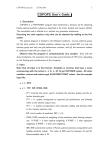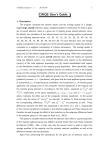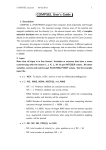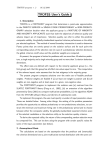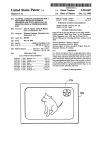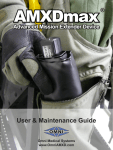Download COPOSS User's Guide
Transcript
COPOSS program 30/03/2011 1 COPOSS User’s Guide 1. Description COPOSS is a FORTRAN77 program that implements a decision aid for designing Pareto-optimal selection systems for general selection decision situations (cf. De Corte, Sackett & Lievens, in press). The executable code is offered as is, without any guarantee whatsoever. The present program has the following limitations: (a) the total number of analyzed selection scenarios may not exceed 50 and scenarios involving more than three stages are not allowed, (b) only one minority group and only one job performance criterion, (c) the two selection goals are fixed: expected job performance of the selected applicants for the selection quality and the adverse impact ratio for the selection diversity goal, (d) only predictors administered in the first stage can be qualified as “non-compensatory”,and (e) the maximum number of trade-offs per scenario is 50. Observe that the program is computationaly very complex. Even with the above limitations, the execution time may take several hours of CPU time, depending on the floating point performance of the computer and the number of high stage scenarios. Inclusion of non-compensatory scenarios will boost the execution time. 2. Input Note that all input is in free format: Variables or vectores that have a name commencing with the letters I, J, K, L, M, N get INTEGER values. All other variables, vectors and matrices get FLOATING POINT values. See the example input file. • # 1: KEY. To obtain a KEY, send an e-mail to [email protected] • # 2: INA, NP, NF, IFWE, IBN – INA: INA controls whether or not all thusfar administered predictors are used in forming the stage specific predictor composites. If INA = 1, only the stage specific administered predictors are used; if INA = 0, all thusfar administered predictors are used. – NP: total number of available predictors (NP ≤ 10) – NF: Maximum number of selection stages (NF ≤ 3) – IFWE: IFWE controls the weighting of the predictors when forming composites. If IFWE = 0 then optimal weighting; if IFIWE = 1 then regression weighting; if IFIWE = 2 then unit weighting COPOSS program 30/03/2011 2 – IBN: IBN controls the number of Pareto-optimal solutions computed for each scenario. The value of IBN must be between 10 and 50. Recommended values are 20 ≤ IBN ≤ 50. • # 3: NRWE, WMA. Only required if IFWE = 0!!. If IFWE equals 1 or 2, this line should not be specified in the input file. – NRWE: If NRWE = 0, then the predictor weighting when forming predictor composites must obey a ratio constraint. No such ratio constraint if NRWE = 1. – WMA: The ratio between the largest and the smallest predictor weight when forming composites must be between 1/WMA and WMA. If NRWE = 1, a value for WMA must be specified, but the value is ignored. • # 4: SELR, COLIM, PMIN, CESMIN – SELR: Final selection ratio of the selection – COLIM: Maximum total predictor costs per applicant. – PMIN: proportion of minority applicants in the total applicant group – CESMIN: Criterion effect size (i.e., mean difference on the performance criterion between the minority and the majority applicant populations. If the mean criterion performance in the minority population is less than the mean performance in the majority population then CESMIN should have a NEGATIVE value; positive otherwise. • #5: PESMIN(I), I = 1, NP Vector of length NP with the effect sizes of the available predictors. All effect sizes are for the minority population relative to the majority population. So, if the mean predictor performance in the minority population is less than the mean performance in the majority population, then PESMIN should have NEGATIVE values. • #6 and following NP-2 lines: Set of NP-1 lines specifying CP(I,J) (with I = 1, NP-1 and J = I+1, NP) the correlation matrix of the NP predictors. Note that the strict upper diagonal part of the correlation matrix must be specified! (see example) • #7: PVAL(I), I = 1, NP Vector of length NP with the validities of the available predictors. COPOSS program 3 30/03/2011 • #8: PCOST(I), I = 1, NP Vector of length NP with the predictor cost PER APPLICANT of the available predictors. • #9 and following 2*(NF-1)-1 lines: Minimum and maximum permissible retention rates in the selection stages. If NF = 1 then record #9 must be skipped!!. The set up of lines #9 and following is at follows. For each stage J, with 1 ≤ J ≤ (N F − 1), two lines are specified. The first of these lines contains the minimum permissible retention rates in the stages 1 to J-1, whereas the second line contains the maximum permissible retention rates in the stages 1 to J-1. Note that all retention rate values are relative with respect to the initial total applicant group! • #10: MIP(I), I = 1, NF and MAP(I), I = 1, NF First, the set of minimum numbers of predictors that must be used for the 1, 2, .., NF stage selection scenarios. Next, the set of maximum numbers of predictors that must be used for the 1, 2, .., NF stage selection scenarios. Note that the specification of MIP and MAP can be used to eliminate selection scenarios with I stages by specifying that MIP(I) > MAP(I). • #11 and NP-1 following lines: For each available predictor a single line which specifies how the predictor can (or must) be used in the 1, 2, .., NF selection scenarios. The first element of the line specifies how the predictor can (or must) be used in single stage scenarios, the following two elements indicate how the predictor can (or must) be used in the first and the second stage of two stage selections, and so on. The coding of the usage modalities is always the same. A code of 0 indicates that the predictor can not be used; a code equal to 2 indicates that the predictor must be used; a code equal to 1 indicates that the predictor can be used. Finally, a code equal to 3 indicates that the predictor must be used, either in the stage where it receives a code of 3 or in one of the other stages where the usage of the predictor is also coded as 3. Consider the following example line for one of the predictors: 1 1 0 1 0 0 The line specifies that the predictor can be used in the single stage scenarios, can (but must not) be used in the first stage of the two stage scenarios, can not be used in the second stage of the two stage scenarios, and can (but must not) be used only in the first stage of the three stage scenarios. Consider next the following line for a predictor. 1 0 2 0 0 2 COPOSS program 4 30/03/2011 The line shows that the predictor can be used in the single stage scenarios, must be used in the second stage of the two stage scenarios and must be used in the final stage of the three stage scenarios. Finally, the following line 1 3 3 1 1 0 This line tells that the predictor can be used in the single stage scenarios, must be used, either in the first or the second stage of the two stage scenarios, and can be used either in stage 1 or stage 2 of the three stage scenarios. • #12: INC(I), I = 1, NP with INC a vector of NP elements where the Ith element indicates whether predictor I is used compensatory (i.e., INC(I) = 0) or non-compensatory (i.e., INC(I) = 1) in the first stage of the scenario. • #12: VNC(I), I = 1, NP with VNC a vector of NP elements where the Ith element indicates the cut off value to be used for the predictor if this predictor is used non-compensatory. For example, if VNC(I) = -0.5 this means that predictor I is used non-compensatory with cut off value equal to -0.5 (relative to the mean of this predictor in the majority population and assuming that this predictor has variance equal to 1 in the majority population) IF this predictor is used in the first stage of the scenario. If INC(I) is equal to zero, then a value must be set for VNC(I), but the value is ignored. 4. Sample Input File Important: in preparing the input file, use a simple text editor such as Notepad, Wordpad or any other standard ASCII producing editor. DO NOT USE TEXT PROCESSING PROGRAMS SUCH AS MS-WORD or WORDPERFECT. Also, when saving the input file in Notepad, use the option “All Files” in the “Save as type” box. When saving in Wordpad, use the “Text Document-MS-DOS Format” option in the “Save as type” box, and be aware that Wordpad has the nasty habit of adding the extension .txt to the file name that you specify. Thus, with Wordpad, if you specify the name of the input file as “MINPUT”, the file will in fact be saved as “MINPUT.TXT”; and this is the name that you have to use in the command to run the present programs. Here is a sample input file (without the first line containing the KEY!!!), for the COPOSS program. 1 5 3 0 50 0 5. .10 100. .12 -.27 -.72 -.31 -.06 -.57 -.04 0.310 0.030 0.370 0.000 COPOSS program 5 30/03/2011 0.260 0.170 0.000 0.310 0.390 0.250 0.510 0.480 0.220 0.320 20. 150. 20. 20. 20. 0.250 0.500 0.400 0.200 0.800 0.500 5 5 5 5 5 5 1 1 0 1 0 0 1 0 1 0 0 1 1 1 1 1 1 0 1 1 1 1 1 0 1 1 1 1 1 0 0 0 0 0 0 0. 0.0 0.0 0.0 0.0 0.410 5. Running the Program Suppose you copied the executable code of the program to the C:ssel directory on your machine. In that case, the input file must also be saved in the C:ssel directory. Next, to run the program, you have to open an MS-DOS Command window. The way to do this varies from one operating system (i.e., XP, Vista, Windows 7 a.s.o.) to the other, and you should use your local “HELP” button when in doubt about this feature. If the MS-DOS Command window does not automatically open with the prompt C:\>, then you type in the MS-DOS Command window C:, followed by RETURN or ENTER, and your computer will return the C:\> command prompt. Next, you type cd ssel after the C:\> command prompt, again followed by RETURN or ENTER, and your computer will respond with the C:\ssel> command prompt. Now, you can execute the program by typing coposs < minput > moutput where “minput” is the name of the input file and “moutput” is the name of the output file. At the end of the execution, the PC will return the command prompt C:\ssel>. You can then inspect the output by editing the output file with either Notepad, Wordpad or any other simple editor program. 6. Sample Output and Description The above input file corresponds to the file coposs.imcr at the web page http://users.ugent.be/ wdecorte/software.html. The corresponding output is the file coposs.omcr. Note that the web page documents several other example input and output files. Here we comment certain features of the coposs.omcr output file. OPTIMIZATION RESULTS OVERVIEW SCENARIO 1 Predictors used in stage 1: 1 2 3 4 5 The computation FAILED for maximum quality: INFEASIBLE SCENARIO COPOSS program 6 30/03/2011 Comment: This indicates that the scenario is infeasible, typically because the cost per applicant is too high. OPTIMIZATION RESULTS OVERVIEW SCENARIO Predictors used in stage 1: 1 5 Predictors used in stage 2: 3 4 Predictors used in stage 3: 2 13 OVERVIEW PARETO-OPTIMAL SELECTION SYSTEMS AND CORRESPONDING TRADE-OFFS AI Quality 0.60589 0.76365 Sel ratio in the stages 0.750000 0.200000 0.100000 Pred. weights stage 1 : 0.0985 0.4923 Pred. weights stage 2 : 0.0000 0.0000 0.2440 0.0488 Pred. weights stage 3 : 0.0000 0.0000 0.0000 0.0000 0.4800 AI Quality 0.60431 0.77416 Sel ratio in the stages 0.720932 0.200000 0.100000 Pred. weights stage 1 : 0.0985 0.4923 Pred. weights stage 2 : 0.0000 0.0000 0.2440 0.0488 Pred. weights stage 3 : 0.0000 0.0000 0.0000 0.0000 0.4800 LINES DELETED AI Quality 0.38282 1.07964 Sel ratio in the stages 0.400000 Pred. weights stage 1 : 0.3555 Pred. weights stage 2 : 0.0000 Pred. weights stage 3 : 0.0000 AI Quality 0.37389 1.08012 Sel ratio in the stages 0.400000 Pred. weights stage 1 : 0.3777 Pred. weights stage 2 : 0.0000 Pred. weights stage 3 : 0.0000 R PLOT OUTPUT FIRST 0.6059, 0.6043, 0.5944, 0.5932, 0.5824, 0.5795, 0.5589, 0.5528, 0.5083, 0.5017, 0.4532, 0.4460, 0.3914, 0.3828, 0.7637, 0.7742, 0.8493, 0.8602, 0.9342, 0.9428, 1.0034, 1.0077, 1.0356, 1.0392, 1.0618, 1.0645, 1.0786, 1.0796, CPU TIME IN SECONDS 0.293333 0.100000 0.5164 0.0000 0.0784 0.3075 0.0000 0.0000 0.0000 0.4800 0.293333 0.100000 0.5083 0.0000 0.0625 0.3127 0.0000 0.0000 0.0000 0.4800 AI THEN QUAL 0.6028, 0.6013, 0.5920, 0.5908, 0.5766, 0.5738, 0.5466, 0.5404, 0.4950, 0.4882, 0.4386, 0.4311, 0.3739, 0.7847, 0.7953, 0.8713, 0.8823, 0.9516, 0.9604, 1.0119, 1.0161, 1.0428, 1.0462, 1.0671, 1.0695, 1.0801, 74.29 0.5998, 0.5897, 0.5710, 0.5341, 0.4814, 0.4234, 0.5984, 0.5886, 0.5682, 0.5278, 0.4745, 0.4157, 0.5971, 0.5877, 0.5655, 0.5214, 0.4675, 0.4077, 0.5957, 0.5853, 0.5628, 0.5149, 0.4604, 0.3997, 0.8060, 0.8935, 0.9692, 1.0202, 1.0495, 1.0717, 0.8168, 0.9047, 0.9781, 1.0242, 1.0528, 1.0738, 0.8276, 0.9161, 0.9870, 1.0281, 1.0559, 1.0757, 0.8384, 0.9255, 0.9961, 1.0319, 1.0589, 1.0773, COPOSS program 7 30/03/2011 Comment: For each feasible scenario, the output provides the details of the predictors administered in the stages, an overview of an evenly distributed subset of the Paretooptimal AIR and Quality trade-offs, and a summary of these trade-off values that can be used as input for plotting the Pareto front using the freely available R software package (http://cran.r-project.org). Note that the latter summary first lists the AIR values of the Pareto-optimal trade-offs and subsequently the corresponding quality values (i.e., the values of the expected job performance of the selected applicants). Thus, the first Pareto-optimal trade-off has an AIR value of .6059 and a quality value of .7637; the second trade-off shows values of .6043 and .7742 for AIR and quality, and so on. The same format for reporting the Pareto-optimal trade-off values for the selection objectives is used again in several subsequent parts of the output. Each Pareto-optimal trade-off is detailed in terms of the corresponding retention rate (with respect to the total initial applicant group) at the end of each stage, and the weighing of the predictors in the stages. Within each stage, the predictor weights are scaled so that the variance of the predictor composite equals the squared validity of the composite. Finally, within each stage, the order of the predictor weights corresponds to the order of the predictors detailed at the beginning of the output for the scenario. Thus, for the above scenario, the order of the predictors is 1, 5, 3, 4, 2; and the stage 1 weights correspond to the predictors 1 and 5, the stage 2 weights correspond to the predictors 1, 5, 3 and 4 in that order; and the stage 3 weights are in the order 1, 5, 3, 4 and 2. NUMBER PARETO OPTIMAL SOLUTIONS 60 SORTED PARETO OPTIMAL QUALITY 0.8390, 0.8481, 0.8572, 0.8662, 0.9448, 0.9484, 0.9520, 0.9556, 0.9787, 0.9818, 0.9849, 0.9879, 0.9997, 1.0025, 1.0055, 1.0137, 1.0536, 1.0605, 1.0668, 1.0731, 1.1035, 1.1093, 1.1150, 1.1206, 1.1464, 1.1508, 1.1549, 1.1586, 1.1688, 1.1734, 1.1776, 1.1809, 0.8752, 0.9591, 0.9909, 1.0218, 1.0793, 1.1261, 1.1588, 0.8841, 0.9627, 0.9939, 1.0299, 1.0854, 1.1315, 1.1617, 0.8930, 0.9721, 0.9968, 1.0379, 1.0915, 1.1367, 1.1639, 0.9411, 0.9754, 0.9973, 1.0458, 1.0975, 1.1416, 1.1639, SORTED PARETO OPTIMAL AI RATIO 0.6701, 0.6655, 0.6609, 0.6563, 0.6372, 0.6328, 0.6284, 0.6239, 0.6044, 0.6004, 0.5964, 0.5922, 0.5749, 0.5704, 0.5698, 0.5641, 0.5348, 0.5281, 0.5208, 0.5134, 0.4759, 0.4682, 0.4604, 0.4525, 0.4109, 0.4020, 0.3928, 0.3832, 0.3570, 0.3480, 0.3385, 0.3281, 0.6516, 0.6194, 0.5880, 0.5583, 0.5060, 0.4445, 0.3744, 0.6468, 0.6148, 0.5837, 0.5526, 0.4986, 0.4363, 0.3731, 0.6420, 0.6118, 0.5793, 0.5467, 0.4911, 0.4281, 0.3658, 0.6415, 0.6082, 0.5754, 0.5408, 0.4835, 0.4196, 0.3622, COPOSS program 8 30/03/2011 MATCHING SELECTION SCENARIOS 3, 3, 3, 14, 14, 14, 11, 11, 11, 11, 11, 5, 5, 5, 5, 5, 5, 5, 5, 5, 5, 3, 3, 3, 3, 14, 11, 5, 5, 5, 5, 3, 3, 14, 11, 5, 5, 5, 3, 3, 14, 11, 5, 5, 5, 5, 3, 11, 11, 5, 5, 5, 3, 14, 11, 5, 5, 5, 5, 5, Comment: This part of the output details the global Pareto-optimal front, meaning that the listed trade-offs are optimal across the entire set of feasible selection scenarios. In this case, 60 of the Pareto-optimal trade-offs, as obtained for the 16 different selection scenarios, are globally Pareto-optimal. For each globally Pareto-optimal trade-off, the output mentions the value of the quality objective (equal to .8390 for the first globally Pareto-optimal trade-off), the value of the corresponding AIR (equal to .6701 for the first globally Pareto-optimal trade-off), and the identity of the corresponding selection scenario (i.e., scenario 3 for the first globally Pareto-optimal trade-off). Observe that the present global Pareto-optimal front is based on the discrete approximations of the scenario specific Pareto fronts. The front is therefore referred to as the discrete global Pareto-optimal front. SUMMARY TABLE PARETO-OPTIMAL SYSTEMS AND TRADE-OFFS Sy. 1 Sc. 3 Qual. 0.839 AI R. 0.670 2 3 0.848 0.666 St. St. St. St. Rt. 1 2 1 2 Rte 0.316 0.100 0.316 0.100 Predictor 0.061 ( 0.096 ( 0.061 ( 0.108 ( St. St. St. St. 1 2 1 2 0.316 0.100 0.316 0.100 0.522 0.432 0.527 0.435 weights 1) 0.306 2) 0.096 1) 0.306 2) 0.096 ( ( ( ( 3) 4) 3) 4) 1) 2) 1) 2) ( ( ( ( 3) 4) 3) 4) 0.478 ( 5) 0.482 ( 5) LINES DELETED 59 3 1.178 0.338 60 3 1.181 0.328 ( ( ( ( 0.145 0.086 0.105 0.087 Comment: This section provides the details of the selection systems that correspond to the discrete globally Pareto-optimal trade-offs. Thus, globally Pareto-optimal system number 1 corresponds to implementing scenario 3, using a predictor composite of predictors 1 and 3 (with weights .061 and .306) in stage 1 and retaining the .316 highest scoring individuals on this composite; and using a composite of predictors 2, 4 and 5 (with weights .096, .096 and .478, respectively) in the second stage to select the .1/.316 × 100 = 31.6 percent highest scoring individuals on the second composite, resulting in an overall selection (retention) rate (with respect to the initial total applicant 0.432 ( 5) 0.429 ( 5) COPOSS program 9 30/03/2011 group) of .10. So, the value of the selection retention rate mentioned for each selection stage always expresses the fraction of the total initial applicant group that is retained at the end of the stage. NUMBER PARETO OPTIMAL SOLUTIONS 0 FOR 1 STAGES ONLY NUMBER PARETO OPTIMAL SOLUTIONS 59 FOR 2 STAGES ONLY SORTED PARETO OPTIMAL QUALITY 0.8390, 0.8481, 0.8572, 0.8662, 0.9106, 0.9193, 0.9279, 0.9364, 0.9609, 0.9643, 0.9687, 0.9726, 0.9973, 1.0055, 1.0137, 1.0218, 1.0605, 1.0668, 1.0731, 1.0793, 1.1093, 1.1150, 1.1206, 1.1261, 1.1508, 1.1549, 1.1586, 1.1588, 1.1734, 1.1776, 1.1809, 0.8752, 0.9447, 0.9761, 1.0299, 1.0854, 1.1315, 1.1617, 0.8841, 0.9453, 0.9809, 1.0379, 1.0915, 1.1367, 1.1639, 0.8930, 0.9529, 0.9832, 1.0458, 1.0975, 1.1416, 1.1639, 0.9018, 0.9554, 0.9891, 1.0536, 1.1035, 1.1464, 1.1688, SORTED PARETO OPTIMAL AI RATIO 0.6701, 0.6655, 0.6609, 0.6563, 0.6323, 0.6273, 0.6222, 0.6170, 0.6005, 0.5979, 0.5946, 0.5923, 0.5754, 0.5698, 0.5641, 0.5583, 0.5281, 0.5208, 0.5134, 0.5060, 0.4682, 0.4604, 0.4525, 0.4445, 0.4020, 0.3928, 0.3832, 0.3744, 0.3480, 0.3385, 0.3281, 0.6516, 0.6117, 0.5883, 0.5526, 0.4986, 0.4363, 0.3731, 0.6468, 0.6069, 0.5867, 0.5467, 0.4911, 0.4281, 0.3658, 0.6420, 0.6062, 0.5817, 0.5408, 0.4835, 0.4196, 0.3622, 0.6372, 0.6029, 0.5811, 0.5348, 0.4759, 0.4109, 0.3570, 3, 3, 3, 5, 5, 5, 5, 3, 5, 5, 5, 5, 5, 3, 3, 3, 3, 5, 5, 5, 5, 3, 5, 5, 5, 5, 5, 3, MATCHING SELECTION SCENARIOS 3, 3, 3, 3, 3, 3, 3, 5, 3, 5, 5, 5, 5, 5, 5, 5, 5, 5, 5, 5, 5, 3, 3, 3, 3, 3, 5, 5, 5, 5, 3, Comment: This part of the output details the discrete approximation of the globally Pareto-optimal front as obtained over all the two stage selection scenarios. NUMBER PARETO OPTIMAL SOLUTIONS SORTED PARETO OPTIMAL QUALITY 0.9411, 0.9448, 0.9484, 0.9520, 0.9754, 0.9787, 0.9818, 0.9849, 0.9997, 1.0025, 1.0054, 1.0082, 1.0220, 1.0247, 1.0274, 1.0301, 1.0435, 1.0461, 1.0488, 1.0514, 58 FOR 3 STAGES ONLY 0.9556, 0.9879, 1.0110, 1.0328, 1.0541, 0.9591, 0.9909, 1.0138, 1.0355, 1.0567, 0.9627, 0.9939, 1.0165, 1.0381, 1.0594, 0.9721, 0.9968, 1.0193, 1.0408, 1.0620, COPOSS program 1.0646, 1.0846, 1.1019, 10 30/03/2011 1.0671, 1.0869, 1.1032, 1.0697, 1.0893, 1.0722, 1.0916, 1.0747, 1.0939, 1.0772, 1.0960, 1.0797, 1.0981, 1.0821, 1.1001, SORTED PARETO OPTIMAL AI RATIO 0.6415, 0.6372, 0.6328, 0.6284, 0.6082, 0.6044, 0.6004, 0.5964, 0.5749, 0.5704, 0.5659, 0.5613, 0.5379, 0.5331, 0.5284, 0.5236, 0.4994, 0.4945, 0.4896, 0.4848, 0.4601, 0.4551, 0.4500, 0.4449, 0.4187, 0.4134, 0.4079, 0.4024, 0.3723, 0.3649, 0.6239, 0.5922, 0.5567, 0.5187, 0.4799, 0.4397, 0.3967, 0.6194, 0.5880, 0.5520, 0.5139, 0.4750, 0.4345, 0.3910, 0.6148, 0.5837, 0.5474, 0.5091, 0.4700, 0.4293, 0.3851, 0.6118, 0.5793, 0.5426, 0.5042, 0.4651, 0.4241, 0.3789, 14, 11, 11, 11, 11, 11, 11, 14, 11, 11, 11, 11, 11, 11, 14, 11, 11, 11, 11, 11, 11, 11, 11, 11, 11, 11, 11, 11, MATCHING SELECTION SCENARIOS 14, 14, 14, 11, 11, 11, 11, 11, 11, 11, 11, 11, 11, 11, 11, 11, 11, 11, 11, 11, 11, 11, 11, 14, 11, 11, 11, 11, 11, 11, Comment:This part of the output details the discrete globally Pareto-optimal front as obtained over all the three stage selection scenarios. GLOBAL PARETO FRONT AI Ratio 0.3281, 0.3315, 0.3550, 0.3584, 0.3820, 0.3852, 0.4088, 0.4122, 0.4358, 0.4391, 0.4626, 0.4659, 0.4895, 0.4928, 0.5162, 0.5196, 0.5431, 0.5464, 0.5698, 0.5732, 0.5964, 0.5998, 0.6230, 0.6262, 0.6494, 0.6528, Quality 1.1809, 1.1798, 1.1698, 1.1680, 1.1590, 1.1578, 1.1474, 1.1457, 1.1319, 1.1297, 1.1134, 1.1109, 1.0928, 1.0902, BASED ON B-SPLINE APPROXIMATION 0.3348, 0.3618, 0.3887, 0.4155, 0.4425, 0.4693, 0.4961, 0.5230, 0.5497, 0.5765, 0.6030, 0.6296, 0.6562, 0.3383, 0.3651, 0.3921, 0.4189, 0.4457, 0.4727, 0.4995, 0.5263, 0.5531, 0.5797, 0.6063, 0.6329, 0.6594, 0.3416, 0.3685, 0.3953, 0.4223, 0.4491, 0.4759, 0.5029, 0.5296, 0.5565, 0.5831, 0.6097, 0.6362, 0.6627, 0.3449, 0.3719, 0.3987, 0.4256, 0.4525, 0.4794, 0.5061, 0.5331, 0.5597, 0.5865, 0.6129, 0.6395, 0.6661, 0.3483, 0.3751, 0.4021, 0.4290, 0.4558, 0.4828, 0.5095, 0.5363, 0.5632, 0.5898, 0.6162, 0.6428, 0.6694, 0.3517, 0.3786, 0.4054, 0.4324, 0.4592, 0.4860, 0.5130, 0.5397, 0.5665, 0.5930, 0.6196, 0.6462, 0.6701, 1.1787, 1.1661, 1.1565, 1.1439, 1.1275, 1.1085, 1.0874, 1.1776, 1.1642, 1.1552, 1.1420, 1.1253, 1.1059, 1.0847, 1.1762, 1.1626, 1.1538, 1.1401, 1.1229, 1.1034, 1.0819, 1.1747, 1.1619, 1.1523, 1.1381, 1.1206, 1.1008, 1.0792, 1.1732, 1.1610, 1.1508, 1.1361, 1.1183, 1.0981, 1.0763, 1.1715, 1.1600, 1.1491, 1.1340, 1.1158, 1.0955, 1.0735, COPOSS program 11 30/03/2011 1.0707, 1.0678, 1.0428, 1.0383, 1.0055, 1.0008, 0.9849, 0.9823, 0.9563, 0.9537, 0.8792, 0.8729, Matching Selection 3, 3, 3, 3, 5, 5, 5, 5, 5, 5, 5, 5, 5, 5, 5, 5, 5, 5, 5, 11, 11, 11, 14, 14, 3, 3, 1.0649, 1.0620, 1.0338, 1.0292, 0.9987, 0.9965, 0.9797, 0.9770, 0.9510, 0.9484, 0.8664, 0.8600, Scenarios 3, 3, 3, 3, 5, 5, 5, 5, 5, 5, 5, 5, 5, 5, 5, 5, 5, 5, 11, 11, 11, 11, 14, 14, 3, 3, 1.0589, 1.0245, 0.9942, 0.9741, 0.9455, 0.8536, 1.0554, 1.0198, 0.9920, 0.9641, 0.9428, 0.8471, 1.0516, 1.0150, 0.9896, 0.9615, 0.8917, 0.8403, 1.0472, 1.0103, 0.9873, 0.9590, 0.8854, 0.8390, 3, 5, 5, 5, 5, 5, 5, 5, 5, 11, 11, 14, 3, 3, 5, 5, 5, 5, 5, 5, 5, 5, 11, 14, 14, 3, 3, 5, 5, 5, 5, 5, 5, 5, 5, 11, 14, 3, 3, 3, 5, 5, 5, 5, 5, 5, 5, 5, 11, 14, 3, 3, Comment: This part of the output details a more continuous approximation of the globally Pareto-optimal front as obtained over all (i.e., single, two and three stage) scenarios. The computation of this front proceeds in two steps. In the first step, the Pareto-optimal fronts of the scenarios are approximated using B-spline interpolation. This results in a continuous representation of these fronts. Next, a Pareto filter is used to extract the globally Pareto-optimal front. In general, the thus derived front and the earlier obtained discrete globally Pareto-optimal front will be very similar in shape. However, it may happen that selection scenarios that contribute to the discrete global Pareto-optimal front no longer contribute to the present more continuous approximation of this front. In case of such differences, the latter, more continuous approximation of the global Pareto-optimal front is to be preferred. CONTRIBUTION SCENARIOS TO THE PARETO FRONT SCENARIO AI Ratio 0.3281, 0.3448, 0.3614, Quality 1.1809, 1.1748, 1.1663, SCENARIO AI Ratio 3 0.3302, 0.3468, 0.3635, 0.3322, 0.3488, 0.3655, 0.3343, 0.3509, 0.3675, 0.3365, 0.3530, 0.3675, 0.3385, 0.3552, 0.3406, 0.3572, 0.3427, 0.3593, 1.1803, 1.1739, 1.1652, 1.1796, 1.1729, 1.1640, 1.1789, 1.1719, 1.1628, 1.1782, 1.1708, 1.1628, 1.1776, 1.1697, 1.1767, 1.1687, 1.1757, 1.1675, 5 COPOSS program 0.3676, 0.4507, 0.5336, Quality 1.1628, 1.1218, 1.0548, SCENARIO AI Ratio 0.5730, 0.5887, 0.6044, Quality 1.0009, 0.9904, 0.9787, SCENARIO AI Ratio 0.6119, 0.6243, 0.6370, Quality 0.9649, 0.9552, 0.9450, SCENARIO AI Ratio 0.6415, 0.6533, 0.6651, Quality 0.8939, 0.8720, 0.8491, 12 30/03/2011 0.3781, 0.4611, 0.5440, 0.3885, 0.4714, 0.5543, 0.3988, 0.4819, 0.5646, 0.4093, 0.4921, 0.5729, 0.4196, 0.5026, 0.4300, 0.5130, 0.4404, 0.5232, 1.1602, 1.1145, 1.0416, 1.1566, 1.1068, 1.0275, 1.1523, 1.0988, 1.0130, 1.1472, 1.0907, 1.0009, 1.1416, 1.0822, 1.1355, 1.0735, 1.1289, 1.0647, 0.5749, 0.5907, 0.6062, 0.5769, 0.5926, 0.6082, 0.5789, 0.5946, 0.6101, 0.5808, 0.5965, 0.6118, 0.5828, 0.5985, 0.5847, 0.6004, 0.5867, 0.6024, 0.9996, 0.9890, 0.9771, 0.9983, 0.9877, 0.9754, 0.9970, 0.9862, 0.9737, 0.9958, 0.9848, 0.9721, 0.9944, 0.9833, 0.9931, 0.9818, 0.9917, 0.9803, 0.6135, 0.6260, 0.6384, 0.6150, 0.6276, 0.6401, 0.6166, 0.6291, 0.6415, 0.6181, 0.6307, 0.6197, 0.6322, 0.6212, 0.6338, 0.6229, 0.6353, 0.9637, 0.9539, 0.9437, 0.9625, 0.9526, 0.9424, 0.9613, 0.9514, 0.9411, 0.9601, 0.9501, 0.9589, 0.9488, 0.9576, 0.9476, 0.9564, 0.9463, 0.6430, 0.6548, 0.6664, 0.6444, 0.6563, 0.6680, 0.6460, 0.6576, 0.6694, 0.6473, 0.6592, 0.6701, 0.6489, 0.6606, 0.6503, 0.6621, 0.6518, 0.6635, 0.8913, 0.8691, 0.8463, 0.8885, 0.8662, 0.8433, 0.8857, 0.8635, 0.8403, 0.8831, 0.8606, 0.8390, 0.8803, 0.8577, 0.8775, 0.8550, 0.8748, 0.8520, 11 14 3 Comment: This part of the output details the contribution of the different selection scenarios to the more continuous approximation of the globally Pareto-optimal front. The output enables drawing the global Pareto-optimal front indicating the different scenarios that contribute to the front. COVERAGE GLOBAL PARETO FRONT BY THE SCENARIOS SCENARIO---PROPORTION OF COVERAGE 5 3 11 0.59868 0.19937 0.11450 COPOSS program 14 30/03/2011 13 0.08746 CPU TIME IN SECONDS 541.51 Comment: Details on the proportional contribution of the scenarios to the global Paretooptimal front. Thus, the figures show that scenario 5 offers the largest contribution (almost 60 percent), followed by scenario 3 (nearly 20 percent), and so on. 7. Acknowledgement When the user reports results obtained by the present program, due reference should be made to De Corte (2011) and De Corte, Sackett and Lievens (in press). 8. References De Corte, W. (2011). COPOSS User’s Guide. De Corte, W., Sackett, P., & Lievens, F. (in press). Designing Pareto-optimal selection systems: Formalizing the decisions required for selection system development. Journal of Applied Psychology.













